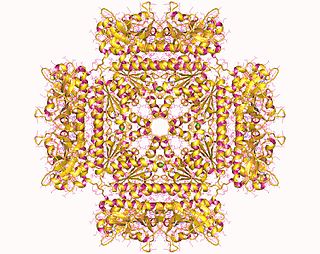| aerobactin synthase | |||||||||
|---|---|---|---|---|---|---|---|---|---|
| Identifiers | |||||||||
| EC no. | 6.3.2.39 | ||||||||
| CAS no. | 94047-30-0 | ||||||||
| Databases | |||||||||
| IntEnz | IntEnz view | ||||||||
| BRENDA | BRENDA entry | ||||||||
| ExPASy | NiceZyme view | ||||||||
| KEGG | KEGG entry | ||||||||
| MetaCyc | metabolic pathway | ||||||||
| PRIAM | profile | ||||||||
| PDB structures | RCSB PDB PDBe PDBsum | ||||||||
| Gene Ontology | AmiGO / QuickGO | ||||||||
| |||||||||
In enzymology, an aerobactin synthase (EC 6.3.2.39) is an enzyme that catalyzes the chemical reaction
- 4 ATP + citrate + 2 N6-acetyl-N6-hydroxy-L-lysine + 2 H2O 4 ADP + 4 phosphate + aerobactin
The 4 substrates of this enzyme are ATP, citrate, N6-acetyl-N6-hydroxy-L-lysine, and H2O, whereas its 3 products are ADP, phosphate, and aerobactin.
This enzyme belongs to the family of ligases, specifically those forming carbon-nitrogen bonds as acid-D-amino-acid ligases (peptide synthases). The systematic name of this enzyme class is citrate:N6-acetyl-N6-hydroxy-L-lysine ligase (ADP-forming). This enzyme is also called citrate:6-N-acetyl-6-N-hydroxy-L-lysine ligase (ADP-forming). This enzyme participates in lysine degradation.




